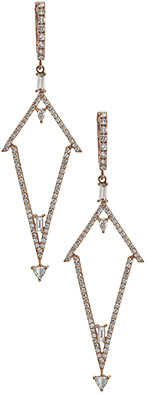|
Cover
Creative Expression
Encouraging designers to be true to their DNA is a key strategic initiative at Plukka, the Hong Kong–based multichannel jewelry retailer.
By Joyce Kauf
 |
| Treliss for Plukka |
“We want to offer exciting jewelry by giving designers a platform of creative expression while we take care of the financing, manufacturing and messaging for them,” says Natalia Obolensky, explaining her business model for Plukka, the Hong Kong–based multichannel jewelry retailer. As CEO, Obolensky seeks to establish exclusive and proprietary relationships with select designers whose passion for diamonds and gemstones reflects the Plukka aesthetic — and that of its highly defined target customer.
“Boiling the customer down to one person” was a starting point for Obolensky, who joined the company in 2016. An entrepreneur and management consultant, Obolensky earned a degree in international relations from Brown University in Providence, Rhode Island, and received her MBA from INSEAD in Fontainebleau, France. She admits that her non-jewelry background enables her to “look outward to the industry with both a consumer- and business-focused lens” as the basis for seamlessly integrating and innovating Plukka’s online and brick-and-mortar business.
Extensive market research identified the Plukka target customer by her exact age — 38 years old — living in an urban center such as New York, London or Paris. She carries a designer handbag and wears designer shoes and reads Vogue or Elle. Above all, according to Obolensky, she is “a style leader in her own milieu, easily identified even if she is classically dressed.” With that information, augmented by sales data from the company’s two stores in Hong Kong and London, Obolensky implemented the first step of her multipronged approach. She undertook a “total revamp” of plukka.com, redesigning the site and paring down its 14,000 SKUs, which “were getting us further away from the core customer we are trying to reach.”
According to Obolensky, the Plukka customer favors designs that are “compelling” rather than “commercial.” However, designers’ creativity is often limited by economic constraints in product execution. “Retailers want to build their retail brand, which conflicts with the story the designers want to tell. When designers work for a specific retailer, the diamond buyer or colored gemstone buyer or gold buyer dictates how these designers fit into that specific retail environment,” Obolensky points out. Furthermore, in most cases, retailers lack the financial resources to support the designer, not only in product development, but in messaging as well. Analyzing the problem from her non-jewelry perspective, she wondered what would happen if those barriers were removed. Obolensky concluded that if Plukka could finance, produce and sell the jewelry, the designers could focus on “what they are really good at — designing, inspiring and telling a story.” To implement this second strategic objective, Obolensky, the outsider, sought an industry insider as her partner.
Treliss Worldwide Inc. is a multigenerational business specializing in sourcing, cutting and manufacturing rough diamonds to finished jewelry. The company, which acquired a stake in Plukka, embraces a philosophy of “creation, inspiration and collaboration” that complements Obolensky’s vision. According to Nirav Mehta, director, “Treliss is able to bring state-of-the-art manufacturing with all the traceability,” noting that the company has been certified by the Responsible Jewellery Council (RJC). Obolensky cites that fact as another asset, given that Plukka wants to be in the forefront of producing and selling sustainable jewelry.
Currently in discussion with designers, Obolensky notes that her message resonates positively with them. In addition to the promise of “being true to their brand without diluting their DNA,” it addresses many of their sales and marketing concerns — typically not their forte. “We tell them, you concentrate on the product development. We can test in the market through product or price testing. We can put it online or in the stores.” As the strategy evolves, Obolensky envisions creating more capsule and exclusive collections with these designers.
In addition to working with established designers, Obolensky is looking to incubate talented designers still in school. She and Mehta plan to work with the Fashion Institute of Technology (FIT) and Parsons School of Design, both in New York City, to identify “the best and the brightest” and support their creativity as they refine and master their skills.
Obolensky acknowledges that she and Mehta are still “figuring out” the company’s offline presence, especially in the U.S., which constitutes still another strategic objective. In 2016, as part of their extensive market research, they created pop-up stores on Madison Avenue in New York City and also in Southampton on Long Island for three months or less. Plukka also partnered with a high-end clothing rental company in Los Angeles to sell jewelry during Oscar season, a prime time for jewelry. The results of these efforts are being evaluated through focus groups to determine optimal locations as well as to support online efforts. “Online and offline have to speak to each other,” says Obolensky, adding, “Whatever we do online has to be reflected offline and vice versa.”
“Plukka is about curation and building that emotional customer connection around a 360 degree approach to creativity,” says Obolensky. “We go to the shows in Paris and London and know what’s happening on the runways. We can speak as the fashion authority. We have the capacity to move quickly and design and execute in a very competitive manner. We can be that voice and we can deliver.” Article from the Rapaport Magazine - June 2017. To subscribe click here.
|
|